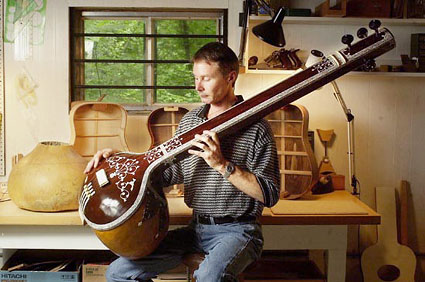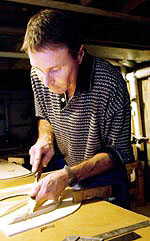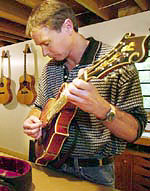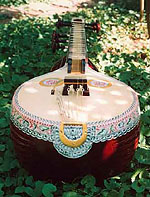
|
|||

By Larry Nager /
A spiritual tone pervades Dave Schneider's instrument making and repair Photos by / Michael Snyder |
A guitar is never just a hunk of wood to Dave Schneider. When the instrument maker-restorer crafts one, he connects with it on a spiritual level.
The clients of the 43-year-old native Cincinnatian agree. “He's a godsend,” says Clare Callahan, professor of classical guitar at the University of Cincinnati-College Conservatory of Music. “I have two or three Ramirez (guitars) and he's done major surgery on them. I've never given him anything he couldn't do. He takes pride in his work, he's not just turning it out to make a buck. That's a special gift.” |
||
Shop like a museumIt's not just guitars on which Mr. Schneider works his magic. His shop in Anderson Township is like a musical museum. Along with the usual six and 12-string acoustic and electric guitars, Stratocasters, arch tops, etc., there are far more exotic instruments. Gourd-bodied Indian sitars, tambouras and massive veenas stand amid their Western brethren. Wooden-cased harmoniums are everywhere. A cross between an accordion and an organ, the bellows driven, portable keyboards were used a century ago by Christian missionaries. They gained wide acceptance in India, where they continue to be used in Hindu chanting. They are experiencing wide popularity in the States in chant/dance gatherings called kirtans. Mr. Schneider is acknowledged as the world's leading harmonium repairer. He even made an instructional video on fixing and tuning the notoriously erratic instruments. Internationally known harmonium player Krishna Dass, an American-born musician and leader of the kirtan movement, sends his instruments to Mr. Schneider. For “K.D.,” as he's known, music is a religious practice. He would only trust his harmoniums to a kindred spirit. “These are not just instruments to me,” says Mr. Dass, speaking from a yoga retreat in Utah. “I make love to God with these things everyday, so it's very special. And I always feel very good about sending them to Dave, knowing they'll come back the best they can be.” Childhood interestsThe twin paths of instrument making and spirituality started early for Mr. Schneider. He was one of five children of Bill and Marilyn Schneider, whom he recalls as life-long religious seekers. His father was an amateur guitarist, woodworker and gadget freak. “I was always there watching what he did. My mother said when I was 5 years old my favorite toy was a little workbench that you pounded little dowels through.”
“It was the 10th richest place in the country. It was like moving to the moon,” he recalls. His homesickness disappeared in the Greenwich High School wood shop. His teacher, Harold Whittle, encouraged him to build a guitar. His first experiments looked good, but details such as top bracing and truss-rods eluded him. The guitars were unplayable. When he went to a local music store for help, he says they told him, “there's a guy named D'Aquisto in Long Island, a really good luthier (stringed instrument maker). Why don't you give him a call?” Meeting the masterThe late Jimmy D'Aquisto was the top guitar maker from the late '60s through the mid-90s. The apprentice of master luthier John D'Angellico, Mr. D'Aquisto's arch-top guitars are among the most highly prized modern instruments, selling in the $100,000 range. Even before his death in 1995, his guitars sold for $40,000. Knowing none of this, the teen-ager made the call. Surprisingly, Mr. D'Aquisto was quite friendly, inviting him to visit his shop in Farmingdale. He complimented the young man's attempts at guitar-making, calling the work “quite clean,” high praise from the meticulous Mr. D'Aquisto. “I was just in total awe,” recalls Mr. Schneider. “This guy was doing this full time and he had a few-year waiting list. The guitars he was making were just phenomenal. He was like a god to me.” They became friends. Mr. D'Aquisto showed him his “circle of sound” bracing pattern and other building tips. But perhaps his most important advice wasn't technical. “He said, "Listen, I've had my shares of setbacks and hard times, too. It's all part of it'.” Connection in IndiaBy the early '80s, Mr. Schneider was back in Cincinnati building instruments full time, first as an apprentice, then as a co-owner with Larry Brown of the Lute & Guitar Shop. He was seriously meditating and began making trips to the Shree Muktananda Ashram in upstate New York. There, he met his primary spiritual teacher, Gurumayi. And he began repairing the musical instruments the Ashram used in chanting. In 1987, he closed his shop and traveled to the ashram (secluded Hindu community) in India. During the eight-month trip, he met Mother Teresa in Calcutta and worked with the instrument makers who build Ravi Shankar's sitars.
“They treat instruments completely different over there. You don't even step over them. In this country, people don't think twice about that. There, it's very disrespectful to step over an instrument. They consider them as beings; they actually do worship them, put different sacred things on them and do chanting, mantras. So I've been doing that. When I finish an instrument up, I put mantras in it.” On returning to the States, he moved to Shree Muktananda Ashram in New York. He became the ashrams' instrument technician. It was at the Ashram that he met his ex-wife Shalini (Canadian-born, she was a baker at the ashram) and yoga teacher John Friend, who introduced him to “K.D.” Back to real worldIn 1997, after 10 years at the ashram, it was time to return to the world. They moved to Cincinnati, where Mr. Schneider tried to revive his business in a Roselawn industrial park. His mother was suffering from pancreatic cancer, and his father had Lou Gehrig's disease (amyotrophic lateral sclerosis). He spent much time traveling to Virginia to be with them, until both died in 1999. His work and marriage suffered. He and his wife separated and divorced last October. It was a stressful time, particularly after life in the ashram. This summer he tried a fresh start, buying an A-frame house in Anderson Towsnhip and moving his shop into the basement. “This is a new beginning. I can feel it in this swarmandala,” he says, gesturing to the unfinished, 36-string, zither-like instrument on his workbench. The traditional Indian instrument is usually constructed of crude wood and nails. But Mr. Schneider has reinvented it, using sophisticated luthiery techniques and the finest spruce and rosewood. But to pay the bills, building often takes a backseat to repair. He has no shortage of customers. He recently restored local blues guitarist Sonny Moorman's beloved 1961 Stratocaster. The guitar had been highly modified, but Mr. Schneider returned it to its original specs, down to the correct primer under the Fiesta Red paint and the exact cloth-covered wiring. “Dave's incredibly meticulous about what he does,” says Mr. Moorman. “He's an obsessive fanatic, and that's what you have to be to do what he does.” Local vintage guitar collector/dealer Gary Dick, who has sold instruments to Keith Richards and Neil Young, agrees. When an old friend willed him a broken '50s Gibson L7 arch top, he had Mr. Schneider restore it. “David is a very sensitive guy, and he got into the whole thing about it being sentimental, and he took it as a challenge. Literally, the thing was in pieces.” Guitars have his soundBuilding guitars remains his first love. With his elaborate headstocks and oval sound holes, his work reflects the influence of his guitar guru, Mr. D'Aquisto. “I had a dream of him about a month ago. He was instructing me,” says Mr. Schneider. “I've come up with a different bracing pattern because of that dream. I feel like he's still with me.” Skeptics may scoff, but the sound of Mr. Schneider's guitars tells the story. Even his simplest instrument delivers startlingly warm tones, rich in harmonics with remarkable sustain. The one-luthier shop is fast becoming a thing of the past, but Mr. Schneider refuses to use modern shortcuts like computerized wood-shaping. That's one reason he charges $7,000 and up for custom guitars. Schneider guitars are made by one man in hundreds of labor-intensive hours. More than mantras or ornamentation, passion gives them their sound. “It's in my heart, the love, the joy of making an instrument,” he says. “Rituals afterwards is one thing. But the love that goes into it while you're making it, that's what people feel.” |
|||
 In his Anderson Township shop, Schneider Guitars, Dave Schneider holds one of his Indian tambouras, a lute-like instrument with four strings
In his Anderson Township shop, Schneider Guitars, Dave Schneider holds one of his Indian tambouras, a lute-like instrument with four strings
 “You pick up the instrument and you can feel it immediately,” he says. “You strum a chord, and you can feel it again. I put my being into this being, and it shows. A lot of people can feel it.”
“You pick up the instrument and you can feel it immediately,” he says. “You strum a chord, and you can feel it again. I put my being into this being, and it shows. A lot of people can feel it.” When Mr. Schneider was 15, his parents moved the family to Greenwich, Conn., to form a spiritual commune with his mother's two brothers and their families. This was no hippie pad. With three families pooling their money, 17 people lived in a luxurious, 26-room mansion.
When Mr. Schneider was 15, his parents moved the family to Greenwich, Conn., to form a spiritual commune with his mother's two brothers and their families. This was no hippie pad. With three families pooling their money, 17 people lived in a luxurious, 26-room mansion. He developed his spiritual connection to instruments.
He developed his spiritual connection to instruments.